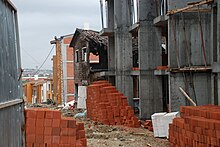Sulukule
Sulukule (Turkish: tower with water / water tower ) is a historic quarter of the Istanbul district of Fatih .
Surname
Sulukule is a collective name for today's districts of Kürkçübaşı, Atikmustafapaşa, Balat, Karabaş, Tahta Minare, Neslişah and Hatice Sultan. The area directly inside the Theodosian Land Wall was the western part of the Byzantine district of Phanari before the Ottoman conquest of Constantinople .
history
Sulukule was considered the oldest Roma district in the world. Roma have lived here for more than a thousand years . The legendary musicians of the quarter were in demand in the Byzantine imperial court.
Sulukule was a problem area in the eyes of the city administration. Unemployment and, as a result, poverty were widespread. In addition, many buildings were built without building permits and with insufficient funds. The residents, who had lived here for generations, had created a form of economy based on entertainment in certain places of entertainment. Customers were offered food, alcohol, Roma music and scantily clad dancing girls. In addition to those directly working in this area, sources of income for street vendors and taxi drivers were created in the area. Under the pretext that prostitution was practiced here, these places, on which practically the entire district was economically dependent, were officially closed in the course of the 1990s.
In spring 2007 some of the simple houses were demolished. In November 2007 the European Parliament also dealt with the demolition and relocation plans. In April and May 2009, the historic quarter was almost completely leveled and sealed off with a fence. The remaining 3400 residents, mostly Roma, had to move to other urban areas. At the end of 2011, a large part of the new development, consisting of three to four-storey terraced houses, was either almost completed or was under construction. Only a few traces of the former buildings were still visible. Sulukule is considered to be a case in point of what is known as gentrification , economic and social restructuring of a traditional lower-class residential area.
Culture
The famous Roma music styles Çiftetelli and Karşılama were characteristic of Sulukule . The most important musical instruments were the violin, çifte nağara (small pair of beaker drums) and the frame drum def . The dancers played finger cymbals ( zil ) . At the end of the 19th century, the older dance style raks was supplemented by influences from Egyptian belly dance . In the 20th century, a mix of styles called oryantal developed , which was also performed by professional wandering dance troupes.
Discography
- Rome Music of Istanbul. Sulukule. Traditional Crossroads 4289, produced by Harold G. Hagopian and Uzeli Plak. New York 1998
Movies
- My house was in Sulukule. Documentary, 94 min., Austria 2010, director: Astrid Heubrandtner
Web links
- Semra Somersam, Süheyla Kırca-Schroeder: Resisting Eviction: Sulukule Roma in Search of Right to Space and Place. Anthropology of East Europe Review, Vol. 25, No. 2, 2010, pp. 96-107
- The Last Days of Sulukule. Mundi Romani (video)
Individual evidence
- ↑ The history of the Roma is simply being dredged away. Spiegel Online, January 21, 2008
- ^ Otan Karaman: Remaking Space for Globalization: Dispossession through Urban Renewal in Istanbul. ( Page no longer available , search in web archives ) Info: The link was automatically marked as defective. Please check the link according to the instructions and then remove this notice. (Diss .; PDF; 1.5 MB) University of Minnesota, 2010, pp. 101-103
- ↑ Sinan Cökçen: Requiem for Sulukule. ( Memento of the original from October 31, 2011 in the Internet Archive ) Info: The archive link was inserted automatically and has not yet been checked. Please check the original and archive link according to the instructions and then remove this notice. (PDF; 819 kB) Roma Rights Journal, 1, 2009, p. 49f
- ↑ Press kit for the film (PDF; 3.7 MB) stadtkinowien.at

